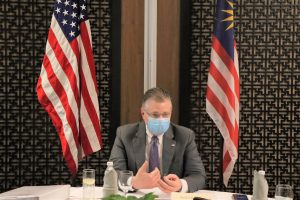A senior U.S. official met with a high-ranking member of the Myanmar armed forces last week in Vietnam, suggesting a possible shift in Washington’s approach to the country’s conflict.
Daniel Kritenbrink, the U.S. assistant secretary of state for East Asian and Pacific Affairs, met Kyaw Lin Zaw. a commander in the Myanmar Navy, in Hanoi on June 21-22, a source with knowledge of the meeting told The Diplomat.
Kritenbrink arrived in Hanoi on a publicized visit on June 21, shortly after the departure of Russian President Vladimir Putin, who paid a state visit to Vietnam last week. The source said that Kritenbrink was accompanied at the meeting by Peter Lohman, director for Southeast Asia of the U.S. National Security Council, and Susan Stevenson, charge d’affaires of the U.S. Embassy in Myanmar.
The U.S. Embassy in Hanoi did not respond to a query about the meeting, but The Irrawaddy quoted a State Department spokesperson as saying that Washington continued “to deploy all diplomatic tools” at its disposal to press the Myanmar military regime to change course.
While the spokesperson did not confirm the meeting between Kritenbrink and Kyaw Lin Zaw, they said that the U.S. “continue[s] to make clear to the military regime – including through limited private channels – that it must end its violence against the people of Burma, release those unjustly and arbitrarily detained, allow unhindered humanitarian access, and respect the will of the people for a return to the path of progress and an inclusive, representative democracy.”
According to the source who spoke with The Diplomat, Kritenbrink and Kyaw Lin Zaw “didn’t reach a breakthrough in the meeting, but they aim to improve communication and will meet again soon.” The U.S. is reportedly seeking to “stabilize the conflict,” end the country’s violence, and open up channels of dialogue with the military. “However, significant differences remain within the regime, suggesting that their requirements may be only partially accepted rather than fully adhered to,” the source said.
While the State Department spokesperson quoted by The Irrawaddy stated that the U.S. policy toward Myanmar has not changed, the face-to-face meeting does seem to suggest that the U.S. is adjusting its approach to the conflict that has engulfed Myanmar since the 2021 coup. So far, the approach has involved the imposition of a range of economic sanctions and public contacts with those opposed to its rule, including the shadow National Unity Government (NUG).
At the same time, on the diplomatic front, Washington has largely deferred to the Association of Southeast Asian Nations (ASEAN) and its Five-Point Consensus peace plan, which was formulated during a special meeting of the bloc in April 2021. Despite the efforts of three successive ASEAN chairs, the plan has so far done little to resolve the conflict, or even bring the various contending factions into indirect dialogue.
Interestingly, the source said that Kritenbrink’s meeting was “no secret in the region” and was being conducted “with the implicit consent of regional countries,” including Vietnam, Singapore, Indonesia, and Thailand. This seems to suggest that some ASEAN member states welcome a more active U.S. role, as a possible supplement to the Five-Point Consensus. One Myanmar-focused journalist claimed that the meeting has also “received nods” from China.
A U.S.-led process of mediation is likely to encounter many of the same obstacles that have confronted ASEAN, even if it is not restricted by the bloc’s “non-interference” principle. The most obvious of these is the zero-sum nature of Myanmar’s conflict, and the fact that neither side is willing to begin negotiations with opponents that they view with mutual hostility as “terrorists.” For this reason, the U.S. outreach is bound to be viewed with skepticism among opponents of the junta. It is also unlikely that the military government will heed U.S. admonitions to cease its violent attempts to repress the resistance to military rule and “respect the will of the people,” though recent reports of the growing discontent within the Myanmar military about junta leader Senior Gen. Min Aung Hlaing’s leadership also offer another interesting angle on the meeting.
However, despite the military government’s rapid loss of territory across the periphery over the past nine months, particularly in Shan and Rakhine states, and the bravery and sacrifice of those who have opposed it, there is no sign that its capitulation is imminent. Given that most wars end with a negotiated settlement of some kind, there is some sense in maintaining open channels of communication in the event that the situation on the ground, or the balance of power at the upper echelons of the Myanmar armed forces, shifts.

































